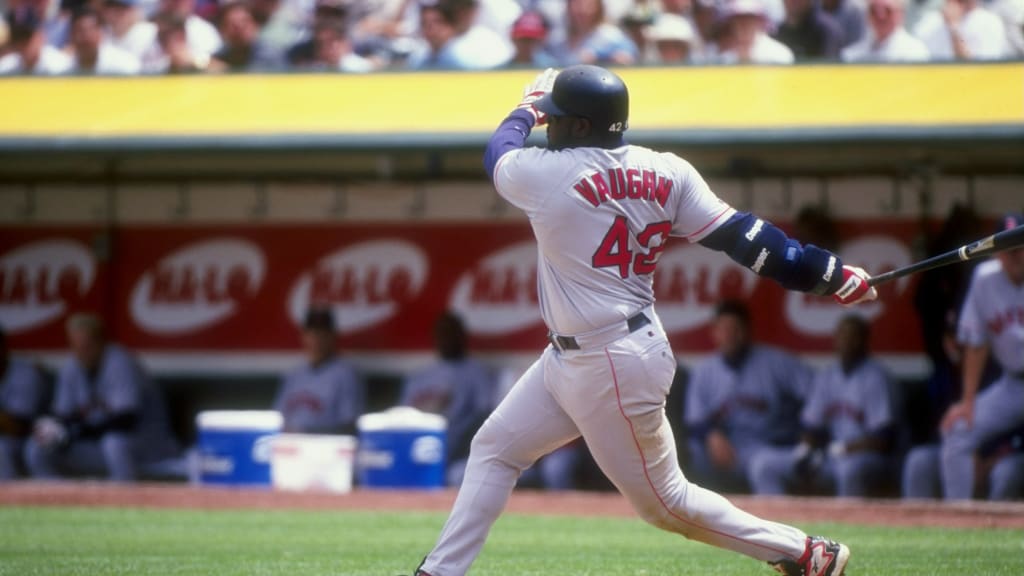
A version of this story was originally published in April 2020.
BOSTON -- Everyone knows that Jackie Robinson was the first African American player to wear No. 42 in the Major Leagues.
A lesser-known fact, however, is this: Who was the last African American Player to don the number that is now retired by all 30 MLB teams?
The answer: Mo Vaughn.
It is not a coincidence that 42 was the only number Vaughn wore in a career in which he ripped 328 homers and had a .906 OPS in 1,512 games -- more than two-thirds of them with the Red Sox.
Vaughn wound up as the last player in franchise history to wear No. 42 for the Red Sox, Angels and Mets because of a Seton Hall coach named Nick Bowness.
“Nick was a great guy, and he wore number 42,” Vaughn told MLB.com. “We kept getting closer over my years at Seton Hall, and he said to me, ‘You’re going to go to the big leagues someday and I want you to wear this number. But you’ve got to look at the history.’”
Vaughn had so much respect for Bowness that his words carried a lot of weight.
“Nick didn’t care who you were, where you came from, whether you were Spanish, black, white; he didn’t care [about] your wealth, your status. He coached you,” said Vaughn. “I think from him is really where I was actually told to understand the history and understand what had taken place. He just exemplified it himself. We talk two or three times a week to this day -- that’s how close we are as people.”
For that reason, Vaughn made it a point to not just know who Jackie Robinson was -- but to study up on him.
“That’s when you start figuring out that he was a really special individual,” Vaughn said. “He was so talented, but it wasn’t really even about talent. It was more about mindset and what can you withstand? [Brooklyn Dodgers general manager] Branch Rickey had to take the guy that he knew could withstand the onslaught of what was going to happen to him. A very well-rounded man is the only person who could do that.”
In 1989, Vaughn was drafted in the first round by the Red Sox, who had been the last MLB team to integrate in ’59. When Vaughn was called up to the Majors in ’91, he would be playing in a city with a notorious history of racial tension.
When Vaughn arrived for his debut on June 27 against the Yankees at Fenway Park, one of the first things he did was ask for No. 42 -- a request that was quickly granted.
“I didn’t wear it in the Minors; the numbers didn’t go up that high,” Vaughn said. “I think they went to like 39. I was going to jump out and wear 44 and then I kind of remembered what [Bowness] told me.”
As Vaughn navigated how to survive and thrive as a black athlete in Boston in the early 1990s, he thought of Robinson.
“Me and Ellis Burks, I think we were the era of black players in Boston that kind of paved the way for the other guys to come and be accepted,” Vaughn said. “We damn sure didn’t go through what Jackie Robinson went through -- I would never say that.
“[Burks] was there when I got there and he kind of showed me the way of what I had to do. I was probably a little more disruptive than Ellis. Ellis was a little quieter than I was. I think we were the beginning of getting a lot of the minority players to come to Boston and feel as if it was a place that anyone could play.”
Though Vaughn was the most popular Red Sox player in the 1990s before Nomar Garciaparra and Pedro Martinez arrived toward the end of the decade, he didn’t reach those heights without some growing pains.
“Listen, did I get hate mail? Yes, I did,” Vaughn said. “But I got more good mail than anything. When I came to that park, people stood up when I walked to the plate. It was a great experience. It was tough, but it was supposed to be tough. You played for the Boston Red Sox -- it’s not supposed to be easy.
“There were expectations before there were expectations. Now there’s an even greater expectation. That whole fan base really made me go as a player. It was never the same when I left. I couldn’t harness that again. It just wasn’t there.”
How did Vaughn make himself so relatable to Boston fans? Aside from being a stud in the batter’s box, he was a pillar in the community.
“I just reached out. Whether it was South Boston, East Boston, North Shore, South Shore, Dudley Square, Roxbury, down the Cape, I was everywhere,” Vaughn said. “That’s what it was supposed to be. I tried to reach kids everywhere, and that’s what it was about.”
Though Vaughn missed the championship renaissance of the Red Sox by a few years -- his last season in Boston was 1998 -- he beams with pride at how diversified the organization has become. He is proud that fans don’t see color when deciding who their favorite player is.
“Some people are put in those positions, and I think that was my contribution [to the Red Sox],” Vaughn said. “You look at David Ortiz right now. Does he sit up there with Tom Brady? Of course he does. Does he sit up there with Larry Bird? Yes, he does. Does he sit up there with Bobby Orr? Yes, he does. Is he on the mantle with [Carl] Yastrzemski and [Ted] Williams? Yes, he is. I think those are the things that I’m most proud of.
“You look at [Xander Bogaerts]. You look at Jackie Bradley Jr. Just look at all the people that have come through over the past championship years. Those were really integrated teams. Players from all different backgrounds and countries -- you’ve got white players, black players, everything. I think that’s the great thing for me watching the Red Sox when we won in 2004 and those other titles up to now. I’m so proud to have some history with them.”
